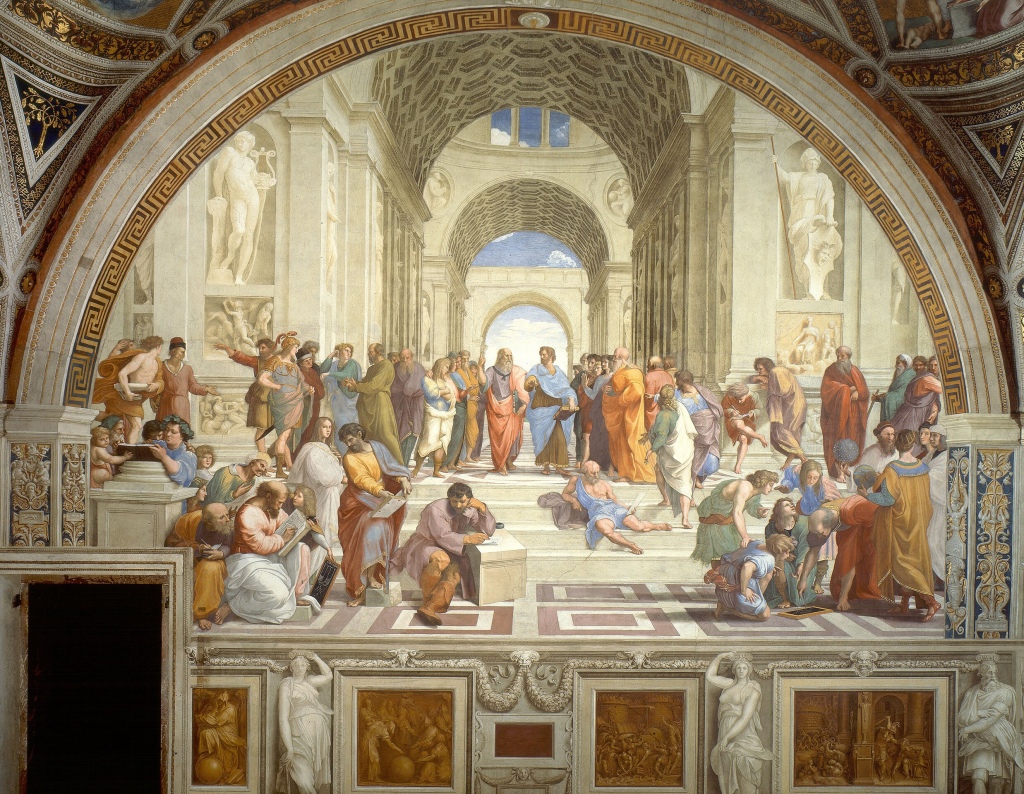

A image of Plato pointing towards the heavens, demonstrating the One. This is taken from Raphael’s painting, “The School of Athens.”
Platohagel: Socrates did you teach Plato about the “Form of the Good?”
Socrates: Indeed, Platohagel, I did impart my teachings to Plato, and among them was the concept of the “Form of the Good.” I proposed that this ultimate form represents the highest reality and serves as the source of all other Forms, guiding one toward truth and virtue.
Platohagel: “The first references that are seen in The Republic to the Form of the Good are within the conversation between Glaucon and Socrates (454 c–d).” Is this the source pertaining to what Plato learnt of the Form of the good? If not, what source Socrates did you draw from?
Socrates: Ah, Platohagel, you have a keen understanding. Yes, the initial references to the Form of the Good are indeed found in the conversation between Glaucon and myself in “The Republic” at 454 c–d. This dialogue laid the foundation for Plato’s exploration and development of the concept.
Platohagel: Socrates, what did Plato mean by, “the Good is the One?”
Socrates: Platohagel, when Plato expressed “the Good is the One,” he aimed to convey the idea that the Form of the Good is singular and unified. It is the ultimate source of reality, illuminating and unifying all other Forms. The concept implies that the Good is the essence that brings coherence and meaning to the multitude of Forms.
Platohagel: Would we say then that the one idea extents to all ideas?
Socrates: Indeed, Platohagel, Plato’s notion suggests that the idea of the One, embodied in the Form of the Good, extends its influence over all other Ideas. It serves as the unifying principle, providing coherence and purpose to the diverse realm of Ideas, guiding them towards their highest potential.

Allegory of the cave. From top to bottom:
https://en.m.wikipedia.org/wiki/Allegory_of_the_cave
- The sun (“the Form of the Good”)
- Natural things (forms)
- Reflections of natural things (mathematical objects)
- Fire (The visible Sun)
- Artificial objects (physical/visible creatures and objects)
- Shadows of artificial objects, allegory (image, illusion, analogy of the sun and of the divided line)
Platohagel: In the illustration of the Allegory of the Cave, was the sun such an example of the one?
Socrates: Yes, Platohagel, in the Allegory of the Cave, the sun is a symbolic representation of the Form of the Good, the ultimate One. Just as the sun illuminates the external world and allows us to perceive it clearly, the Form of the Good sheds light on the true nature of reality, enabling understanding and enlightenment.
Platohagel: Did Aristotle disclaim the Form of the Good as being applicable to material reality?
Socrates: Indeed, Platohagel, Aristotle, my esteemed student, departed from Plato’s theory of Forms. Aristotle did not accept the transcendent Forms, including the Form of the Good, as directly applicable to material reality. Instead, he emphasized the study of the particulars in the physical world to understand their inherent characteristics and purposes. Aristotle sought a more immanent approach to understanding reality.
Platohagel: Socrates do we find this same debate going on in current day approach regarding empiricisms over the idea of a hypothetical?
Socrates: Platohagel, in the contemporary realm, there persists a debate akin to our historical discourse. Empiricism, emphasizing direct sensory experience, contrasts with approaches that entertain hypothetical or abstract constructs. This ongoing dialogue mirrors our ancient contemplation about the nature of knowledge and reality.
Platohagel: Is not this same desire of the One, to imply a unifying existence that would bring all science together, Quantum Mechanics and Relativity?
Socrates: Indeed, Platohagel, the desire for a unifying principle echoes in modern scientific pursuits. Scientists aspire to find a theoretical framework that unifies Quantum Mechanics and Relativity, much like the One’s role in unifying diverse Forms. The quest for a comprehensive understanding of the fundamental nature of the universe persists, echoing the timeless pursuit of unity in knowledge.
Platohagel: So is it possible to say then, that the knowable of that idea, will be the understanding of the One?
Socrates: Certainly, Platohagel, the knowable essence lies in the understanding of the One, or in contemporary terms, a unifying principle that harmonizes diverse branches of knowledge. To comprehend the interconnectedness of various disciplines is to approach a more comprehensive understanding, akin to grasping the nature of the ultimate One.
Platohagel: Akin to grasping the nature of the ultimate One, would we say that such a nature would imply the First Principle?
Socrates: Indeed, Platohagel, the nature of the ultimate One aligns with the concept of a First Principle. It signifies the foundational and all-encompassing principle from which everything emanates, much like the origin and guiding force underlying the diverse facets of existence.
See Also: Beauty: Form Versus Science

No comments:
Post a Comment